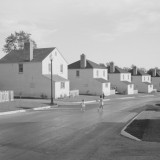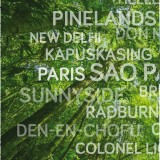Milwaukee County, Wisconsin, United States.
Greendale is one of three government sponsored ‘greenbelt’ communities. The Federal Government’s Resettlement Administration had three main objectives:
- to demonstrate a new kind of suburban community which combined both city and country life,
- to provide good housing at reasonable rents
- to provide jobs to unemployed workers.
Of the three communities, Greendale is most distinctly reflects the Garden City principles of balancing defined urbanity with open landscape. Greendale was designated as a National Historic Landmark in 2013.
Planned in 1936. ‘opened’ for occupancy on 1 May 1938
Original master planner and any other critical master planning, design and architects
Planners Jacob Crane and Edward Peets.
Architects Harry H. Bentley and Walter G. Thomas
Architectural Style/qualities
Anglo-American
Nearly all houses were of two stories, except for the so-called "Honeymooners". All homes had concrete foundations, cincrete (a type of cinder) block walls, and either lightweight tile or slate shingle roofs. A utility room, containing the coal fired furnace and laundry facilities, took the place of a basement. The first floor was finished with asphalt tile on a 2 1/2" concrete slab, supported by precast concrete joists. The second floor was of 7/8" oak or maple. The living room had a beamed ceiling of 8 inch ponderosa pine, with the wood sub floor of the floor above serving as its ceiling finish. (http://www.greendale.org/our_community/historic_greendale/index.php)
Settlement Size
3,410 acres
572 living units in 366 buildings in 1938
Population
14,046 (2010 census)
Governance arrangements
Village President and Trustees
Other notable features that reflect Garden City Principles
generous green space linked to the wider natural environment, including a surrounding belt of countryside to prevent sprawl,
well connected and biodiversity rich public parks, and a mix of public and private networks of well-managed, high-quality gardens, tree-lined streets and open spaces
strong local cultural, recreational and shopping facilities in walkable neighbourhoods
a strong local jobs offer in the Garden City itself, with a variety of employment opportunities within easy commuting distance of homes
strong vision, leadership and community engagement
mixed-tenure homes and housing types that are affordable for ordinary people
Integrated and accessible transport systems – with a series of settlements linked by rapid transport providing a full range of employment opportunities??
“A good community in which you can walk to work and to shops, have good neighbours and a modern home has an air of unreality about it…”
Find out more:
Greendale Historical Society
info@greendalehistoricalsociety.org
http://www.greendalehistoricalsociety.org/greendales-story/
Also:
Greendale Village
http://www.greendale.org

